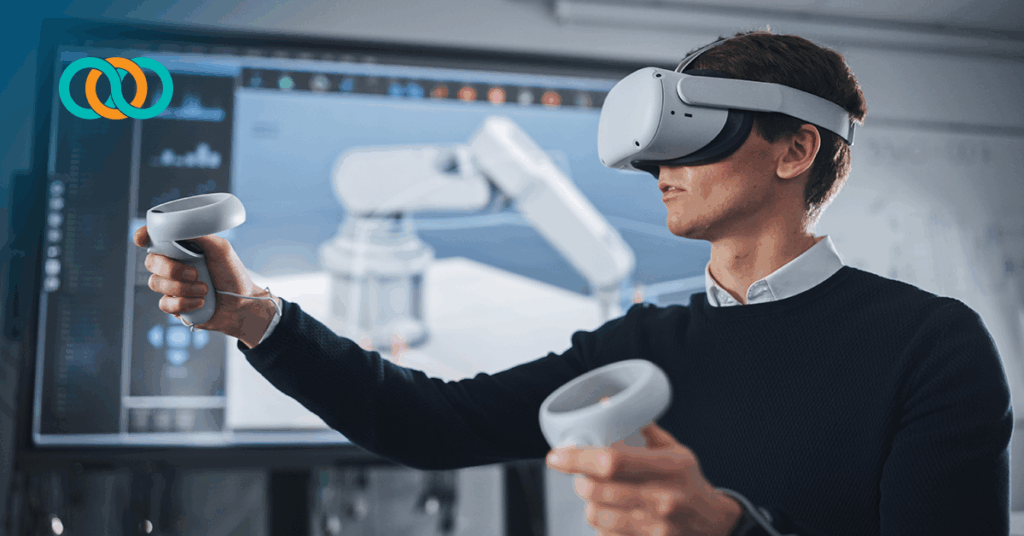Modern AI, VR, and AR technologies are reshaping the ~$340 billion corporate learning industry. AI-driven tools can now process thousands of pages of documentation, translate content into 50+ languages, and generate full instructional courses in record time. Organizations that use AI for eLearning cut development time by half, while experiential learning methods like VR and AR significantly improve knowledge retention.
Today’s instructional design services extend far beyond traditional training. These services help create personalized, tech-enabled learning experiences tailored to each learner’s needs. The industry’s future is digital, interactive, and deeply human-centered.
Research shows that 72% of L&D Leaders believe AI will be crucial for delivering personalized learning experiences within five years. This guide explores how AI, VR, and AR are transforming instructional design services with real-world applications that can help you prepare for what’s next.
The Evolution of Instructional Design Services
Instructional design has undergone a remarkable transformation. Static, one-size-fits-all training has evolved into dynamic, data-informed, learner-driven experiences. With 65% of people preferring visual learning and another 30% identifying as auditory learners, traditional “one format for all” models no longer deliver results.
From Traditional Methods to Tech-Enabled Learning
Education no longer lives only in the classroom. Technology has shifted from simply enhancing lessons to becoming essential to learning itself. This evolution isn’t just about digitizing content; it’s about reimagining how people learn.
AI-powered adaptive learning systems now form the backbone of modern instructional design. These systems adjust difficulty based on learner performance, leading to stronger retention and higher engagement. By analyzing learner data, AI identifies pain points and offers targeted support, making personalization possible at scale.
Why Modern Businesses Need Updated Instructional Design
As technology advances, companies face mounting pressure to help employees learn faster and retain more. Outdated training contributes directly to employee turnover — and turnover costs. By contrast, research shows engaged, well-trained employees can drive a 21% increase in profitability.
Modern hybrid workforces require flexible, multi-platform learning. Today’s L&D teams must blend methods: coaching, on-the-job instruction, apprenticeships, and on-demand learning. Companies that fail to modernize their instructional design risk falling behind competitors with smarter, tech-enabled learning systems.
The Expanding Role of Instructional Design Consultants
Today’s instructional design consultants aren’t just curriculum builders, they’re strategic learning partners. They combine expertise in learning theory, cognitive psychology, and emerging technology to create meaningful experiences that stick.
From multimedia simulations to interactive video, consultants help organizations turn static content into active engagement. Their systematic approach ensures learning is measured, refined, and continuously improved. The results: faster skill acquisition, higher retention, and programs designed to fit specific business goals. Companies that work with instructional design consultants see better learning outcomes, higher employee engagement, improved retention rates, and faster competency achievement.
Download Your Copy of Getting Started as a Contract Instructional Designer : An 8 Step Guide to Launching Your Freelance Career
AI-Powered Instructional Design Services: Real-World Examples
AI is transforming instructional design services from the inside out. Here’s how it’s already delivering measurable results in three key areas.
Creating Microlearning from Long Documents
AI tools can now turn 5,000+ pages of content into digestible learning modules with a single click. Platforms like Arist convert PDFs, DOCX, and PPTX files into interactive microlearning experiences quickly. AI-powered tools help designers extract key insights and summarize complex ideas efficiently.
Beyond efficiency, recap videos can now shrink hour-long training into five-minute summaries, reducing costs by up to 86% per video. This approach mirrors what successful companies are doing in the real world. In one food and beverage industry transformation, training was restructured into 5–10-minute microlearning modules employees completed on-shift, reducing onboarding time by 63 minutes and cutting LMS support tickets by 56%.
AI-Generated Assessments and Quizzes
AI now builds assessments in seconds. Instructional designers can generate 10–12 questions of varying difficulty that align directly with learning objectives. These adaptive systems personalize difficulty as learners progress, increasing engagement by 40%. Companies that integrate AI-generated quizzes report boosts in employee performance on average.
Language Translation and Localization at Scale
Language barriers are no longer blockers. AI-powered translation tools can localize content into over 100 languages, cutting turnaround time by 50% and translation costs by nearly 40%. Advanced systems also generate subtitles and voiceovers that preserve tone and emotional cadence. Some even recognize and translate on-screen text dynamically for seamless design integration.
Want to see how AI is transforming learning design? Check out this video from TrainingPros on Balancing Technology and Human Connection in Learning, which explores how to leverage AI tools while maintaining the human touch that keeps learning meaningful.
VR and AR in Action: Use Cases That Work
Virtual reality (VR) and augmented reality (AR) bring learning to life. These tools create immersive, risk-free environments where employees can practice, fail, and master skills without real-world consequences.
VR for Safety and Compliance Training
Companies using VR for safety training report a 43% drop in lost time from injuries. UPS drivers, for instance, learn four times faster through VR simulations than through traditional methods. Siemens uses VR to replicate high-risk scenarios safely, enabling teams to practice without costly or dangerous outcomes.
AR for On-the-Job Support and Guidance
AR overlays digital guidance directly onto physical tasks. One company’s technicians, for example, use AR to perform HVAC maintenance step-by-step without halting production.
This type of real-time guidance proved transformative in the mobile operations platform rollout at a major hospitality company. By implementing AR-supported training combined with comprehensive change management, hotel teams successfully shifted from paper to mobile operations, improving efficiency and employee confidence company-wide.
Soft Skills Development Through Immersive Simulations
VR isn’t just for hard skills. It’s transforming soft skill development too. Learners show a 275% boost in confidence after practicing communication and empathy skills through VR simulations.
Programs like VirtualSpeech allow employees to rehearse public speaking and customer service in realistic environments. Similarly, VR-based diversity and inclusion training enables learners to “step into someone else’s experience,” building empathy in a way no slide deck ever could.
Remote Collaboration and Team Training in VR
Arthur’s Virtual Office and similar VR platforms reimagine remote collaboration. They replicate the presence and focus of in-person meetings, boosting engagement across distributed teams. At ERGO Group, VR-powered team training has elevated sales performance and client consultation skills across continents, providing an all in immersive, distraction-free virtual environments.
The Future of Instructional Design Services: Balancing Technology and Humanity
Technology may be rewriting the rules of instructional design, but it’s human creativity that gives learning its impact. The next generation of instructional designers must master both, embracing automation without losing empathy, agility, or imagination.
AI is the ultimate assistant, not the replacement. Currently, a high percentage of professionals offering instructional design services use AI tools daily. Using AI to draft outlines, analyze patterns, and generate assets, designers can then focus on learning transfer, emotional intelligence, cultural nuance, and innovative storytelling.
The instructional design consultant’s role has evolved to strategically integrate technology while maintaining the human-centered approach that makes learning stick. The most effective designers know when to automate and when to humanize. They use AI for structure and humans for soul.
Building Flexible, Learner-Centered Ecosystems
Modern design focuses on adaptive ecosystems that flex around each learner’s needs. McKinsey research shows individual-specific learning boosts performance by 11 percentage points. Leading organizations combine responsive technology, personalized goal setting, and coach-supported feedback to achieve this.
Conducting thorough gap analyses ensures training addresses real performance gaps by mapping resources directly to learner data.
Staying Ahead Through Firsthand Experimentation
As AI, VR, and AR technologies rapidly transform the instructional design services landscape, instructional designers can’t afford to wait on the sidelines. The most successful professionals are those who experiment with emerging tools before they’re mandated by clients.
This means setting aside time to test AI prompt engineering with tools like ChatGPT for course outlines, exploring VR platforms to understand their limitations and possibilities, or building sample AR experiences to grasp their practical applications. Small-scale pilots allow designers to learn what works, what doesn’t, and where technology adds genuine value versus where it creates unnecessary complexity.
Leading instructional design thought leader Josh Bersin notes that “the autonomous instructional designer has arrived,” emphasizing how AI tools are fundamentally changing the profession while simultaneously creating new opportunities for those who embrace them strategically. The key isn’t mastering every new tool, it’s developing the agility to quickly assess, adopt, and integrate technologies that genuinely enhance learning outcomes.
Moving from Vision to Reality: Addressing Implementation Hurdles
While the potential of AI, VR, and AR is clear, realizing that potential often hits a wall during implementation. It is one thing to experiment with a new tool and quite another to integrate it into a scalable, high-impact learning ecosystem.
The most critical hurdles organizations face today are not technological, but strategic and talent-based:
- The Specialized Skill Gap: Modern instructional design requires fluency in emerging technologies. L&D teams often lack the in-house expertise needed for specialized tasks, such as VR environment design, complex prompt engineering for AI content generation, or developing the data architecture required for adaptive learning systems. Hiring these full-time specialists is slow and costly, creating an immediate bottleneck for transformation projects.
- Lack of Scalable Strategy: Buying a new AR headset or an AI license is the easy part. The real challenge is strategically integrating these tools into the overall business strategy to ensure the investment yields measurable ROI. Without experienced learning strategists who can map these technologies to specific, high-priority business goals, pilot projects often fail to move beyond the initial testing phase.
The Solution: Strategic Staffing and Expertise on Demand
Organizations cannot afford to wait months or years to build these complex capabilities internally. The fastest, most effective way to overcome the implementation wall is through strategic, temporary expertise.
By engaging fractional Instructional Design Consultants and eLearning Developers who already possess mastery over these advanced tools, companies can bridge the skill gap immediately and launch mission-critical projects faster. As demonstrated across various client engagements, this flexible approach is key to achieving faster time-to-competency. (See TrainingPros’ Case Studies for examples of how specialized staffing accelerates project completion.)
Where We Go from Here
Technology alone doesn’t create transformation. The real power lies in how we wield it. Successful instructional design professionals strike a careful balance, using AI as an assistant while preserving the emotional intelligence and cultural understanding that only humans provide.
The instructional design services field continues advancing at breakneck speed. Companies must adapt quickly or risk falling behind competitors with more effective learning systems. Organizations that succeed will build complete learning ecosystems customized to individual needs while staying committed to continuous experimentation.
One truth emerges clearly: instructional design services are now going beyond creating courses to building complete learning journeys. Whether you lead an L&D department or work as an instructional design consultant, your success depends on how well you harness these technologies while keeping human connections strong. The future belongs to those who embrace both technological progress and timeless learning principles, creating experiences that don’t just inform, but truly transform.
Download Your Copy of 10 Ways L&D Departments Are Using AI In 2025
How TrainingPros Can Help
Building meaningful learning experiences with AI, VR, and AR requires more than just access to new tools; it requires strategy, creativity, and a deep understanding of human learning.
If your organization is exploring how to integrate AI into your learning programs, develop immersive virtual reality simulations, or transform traditional eLearning into engaging experiences, TrainingPros can connect you with seasoned instructional designers, eLearning developers, and learning strategists who make it happen.
At TrainingPros, we start with strategy and pair you with consultants who align technology with your business goals. Whether you’re modernizing onboarding programs, scaling leadership development, or optimizing your tech stack, we help you move from reactive to results-driven learning.
We’re proud to be named a Top 20 Staffing Company by Training Industry, a Smartchoice® Preferred Provider by Brandon Hall Group, and a Champion of Learning by ATD. These honors reflect our ongoing commitment to providing talent that blends innovation with proven instructional design excellence.
When you have more projects than people™, TrainingPros connects you with the right consultant to start your project with confidence. Schedule a Consultation today.
- 1share
- LinkedIn0
- Twitter0
- Facebook0
- Love This1











